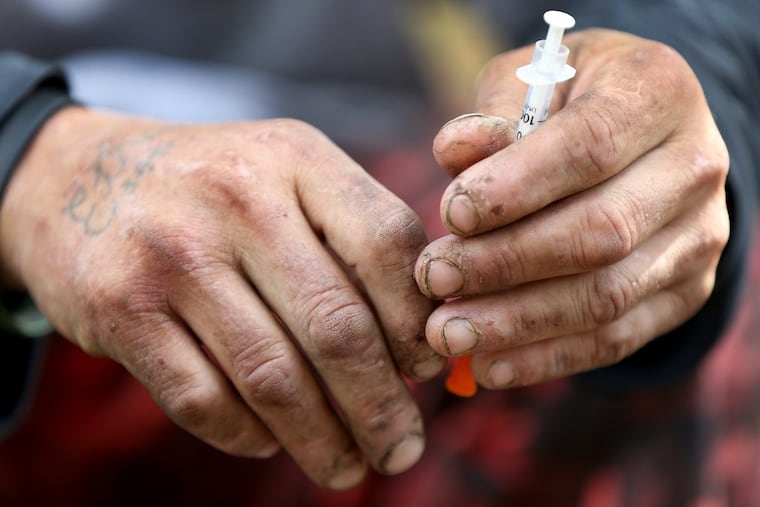The gentrification of addiction: Now that whites are addicted, the language of shame has changed | Solomon Jones
As heroin abuse has begun to overwhelm communities that are undeniably white and rural, the same conservatives who once championed imprisoning drug users now look for ways to blame white addiction on black communities.

For years, America embraced the narrative that addiction was primarily a black and brown problem, especially in cities such as Philadelphia.
But just as our poorest and blackest neighborhoods have been overrun and rebranded by richer and whiter residents, drug abuse is in the midst of a makeover.
I call it the gentrification of addiction.
The numbers tell us why. In 2016, nearly 80 percent of Americans who died from heroin and similar drugs were white. With that truth emblazoned across America's landscape, the language has changed, the problem has been rebranded, and white people who were silent during the African American crack crisis have suddenly recognized addiction as a medical issue.
Tim Golden, a critical race theorist and professor of philosophy at Walla Walla University, has watched the change with mounting concern.
"As if African Americans in the mid- to late '80s who were addicted to crack cocaine — as if that was not a medical issue," he told me in a recent radio interview. "As if it was not a medical issue prior to crack cocaine in the '40s and '50s and '60s and '70s, when heroin was the drug of use in the black community. There was no talk of safe injection sites. There was no talk of trying to have medical personnel oversee the heroin users to make sure that everything was sanitary. There was no talk of that. African Americans were routinely called junkies. That was the lexicon. And now, as you said, because we've moved from an African American prototype of drug addict to a white person, now all of a sudden it's not a war, it's a crisis."
That change in language has come with addiction's change of venue. As heroin abuse has begun to overwhelm communities that are undeniably white and rural, the same conservatives who once championed imprisoning drug users now look for ways to blame white addiction on black communities.
We heard it in 2016 from Maine Gov. Paul LePage, who said, "There are guys with the name D-Money, Smoothie, Shifty — these types of guys — they come from Connecticut and New York, they come up here, they sell their heroin, they go back home. Incidentally, half the time they impregnate a young white girl before they leave."
That kind of racist rhetoric sought to absolve the white addict while simultaneously portraying black and brown people as drug-dealing caricatures. When that didn't sufficiently obscure the reality of white addiction, America sought to change the imagery.
No longer do we see the criminalized images of the black addict that we saw during the war on drugs. Now we see the image of the white sympathetic figure as the face of the opioid crisis.
Golden says the language matters.
"The rhetorical power of the word war implies an enemy, whereas the rhetorical force of the word crisis implies someone in need," Golden told me. "And we have to find a way to reconfigure our language around these issues so that when we talk about drugs, we talk about drugs in terms of crisis no matter who it is."
But the language change around white addiction is not confined to the blame shifting employed by conservatives. The language of white addiction is also evident in the euphemistic wording used by liberals.
Now that dangerous drugs like heroin and fentanyl have begun to decimate the white community, causing an estimated 1,200 overdose deaths last year in Philadelphia alone, we no longer have a war on drugs. We have an opioid crisis.
There are even those who tell us that we must wipe the word addict from our vocabularies, and refer to addiction using its gentrified name— substance use disorder.
Heroin must no longer be referred to as dope. Instead, it's just another opioid.
Helping an addict use drugs is no longer called enabling. It's now lumped in under the helpful phrase "harm reduction."
And by the way, harm reduction is the city's rationale for seeking to open safe injection sites, which many former addicts like myself see as drug houses. At least that's what they were called when they were filled with people of color. Now that addiction has been gentrified, the city wants to support opening new drug houses. They want to staff them with doctors, and they want to call them Comprehensive User Engagement Sites.
But I've lived enough to learn that problems don't go away simply because we change their names. And addiction won't change just because the people who are addicted are white.
"We have to find a way to change the rhetorical method with which we discuss these issues," Golden said. "Because if we don't, we're going to continue to demonize African Americans and we're going to continue to help whites with the same problem. And that to me is just completely unacceptable."
It should be unacceptable to all of us.
Solomon Jones is the author of 10 books. Listen to him weekdays from 10 a.m. to noon on Praise 107.9 FM. sj@solomonjones.com: @solomonjones1
Meet Solomon on Wednesday, April 4, from 12:30 to 1 p.m. at City Hall's courtyard for "A Prayer For The City"